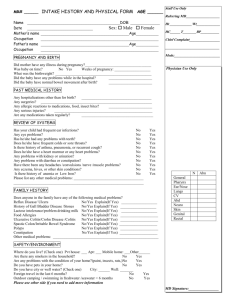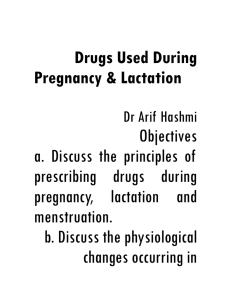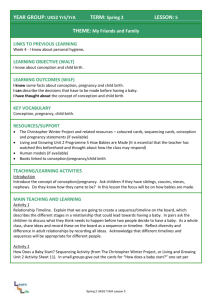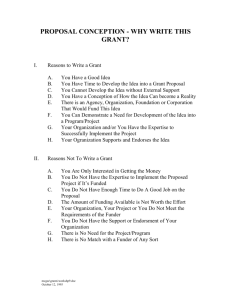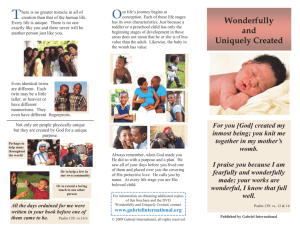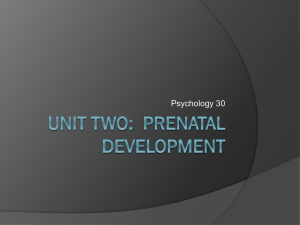Chapter 4 human development
advertisement
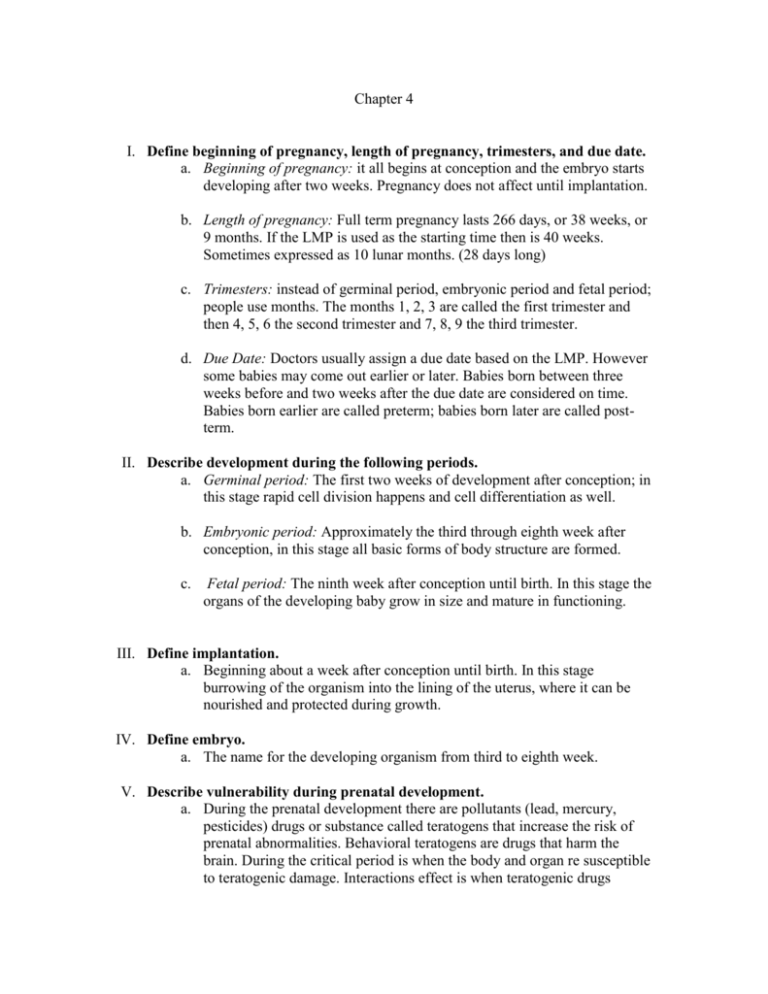
Chapter 4 I. Define beginning of pregnancy, length of pregnancy, trimesters, and due date. a. Beginning of pregnancy: it all begins at conception and the embryo starts developing after two weeks. Pregnancy does not affect until implantation. b. Length of pregnancy: Full term pregnancy lasts 266 days, or 38 weeks, or 9 months. If the LMP is used as the starting time then is 40 weeks. Sometimes expressed as 10 lunar months. (28 days long) c. Trimesters: instead of germinal period, embryonic period and fetal period; people use months. The months 1, 2, 3 are called the first trimester and then 4, 5, 6 the second trimester and 7, 8, 9 the third trimester. d. Due Date: Doctors usually assign a due date based on the LMP. However some babies may come out earlier or later. Babies born between three weeks before and two weeks after the due date are considered on time. Babies born earlier are called preterm; babies born later are called postterm. II. Describe development during the following periods. a. Germinal period: The first two weeks of development after conception; in this stage rapid cell division happens and cell differentiation as well. b. Embryonic period: Approximately the third through eighth week after conception, in this stage all basic forms of body structure are formed. c. Fetal period: The ninth week after conception until birth. In this stage the organs of the developing baby grow in size and mature in functioning. III. Define implantation. a. Beginning about a week after conception until birth. In this stage burrowing of the organism into the lining of the uterus, where it can be nourished and protected during growth. IV. Define embryo. a. The name for the developing organism from third to eighth week. V. Describe vulnerability during prenatal development. a. During the prenatal development there are pollutants (lead, mercury, pesticides) drugs or substance called teratogens that increase the risk of prenatal abnormalities. Behavioral teratogens are drugs that harm the brain. During the critical period is when the body and organ re susceptible to teratogenic damage. Interactions effect is when teratogenic drugs interact increasing the chance of damage. Threshold is the point at which the level of teratogenic substances becomes dangerous. There is also genetic vulnerability, genes determine if a teratogen will be harmful or not. VI. Define fetus, age of viability. a. Fetus: name of the organism from the eight weeks after conception until birth. b. Age of viability: the age (22 weeks after conception) at which the fetus can survive outside the mother’s uterus if specialized medical care is available. VII. Explain how risk is determined by risk analysis. a. Risk is determined by weighing the potential outcomes of a particular event, substance, or experience to determine the likelihood of harm. In teratology, risk analysis involves an attempt to evaluate all the factors that increase or decrease the likelihood that a particular teratogen will cause damage. VIII. How the following teratogens can harm a fetus: a. Rubella: in embryonic period causes blindness and deafness; in first and second trimester causes brain damage. b. AIDS: causes the death of the babies by age 5 due to the body’s inability to defend against virus or illnesses. c. Alcohol: may cause FAS (causes abnormality in the face and mental retardation as well as slow reaction) or FAE. d. Tobacco: increases risk of malformations of limbs and urinary tract, and may affect the baby’s lungs. e. Marijuana: heavy exposure may affect the central nervous system. When smoked may also hinder fetal growth. IX. Define HIV and AIDS. a. HIV: Human Immunodeficiency Virus is a devastating teratogen which gradually overwhelms the body’s natural immune response and eventually leads to AIDS. b. AIDS: Acquired Immune Deficiency Syndrome no longer allows the body to defend against deadly illnesses. X. Identify ways to prevent pediatric AIDS. a. Taking antiretroviral drugs from 14 weeks after conception until birth, give birth by C-section, do not breast feed, and provide antiretroviral drugs for newborn may hugely decrease the chances of transmitting the HIV to baby. XI. Define FAS. a. A cluster of birth defects, including abnormality of the face, slowness of body actions and mental retardation. All caused by mother’s drinking. XII. Define Low birthweight (LBW), preterm birth, and small for gestational age (SGA). a. Low birthweight: is a birthweight of less than 5 ½ pounds. b. Preterm birth: is a birth that occurs 3 weeks or more before the full term of pregnancy has elapsed- at 35 or fewer weeks after conception. c. Small for gestational age: birthweight significantly lower than expected, given the time since conception. A 5 pound baby maybe SGA if born on time but not if two months early. XIII. Identify factors of maternal malnutrition correlated with LBW. a. Factors are prenatal care, maternal use of drugs, overall nutrition, and number of multiple births. XIV. Normal birth of baby. a. They are born head first. The cervix dilates to allow passage, baby’s head moves into birth canal, the baby \’s moves through the colp/o and then emerge is complete. XV. Explain how to use the APGAR scale. a. It is used to assessing newborn’s body functioning. The color, heart rate, reflexes, muscle tone, and respiratory effort are scored ( from 0-2) at one minute and five minutes after birth, and compared with an ideal for healthy babies ( a perfect 10). XVI. Cesarean section. a. Making an incision through the mother’s abdomen and uterus allowing the fetus to be removed quickly, instead of being delivered through the colp/o. b. Percent of Cesarean section on US is about 22%. XVII. Define Cerebral palsy, anoxia, parental alliance, postpartum depression, and parent-newborn bond. a. Cerebral palsy: is a disorder that results from damage to the brain’s motor centers. People have difficulty with muscle control. b. Anoxia: a lack of oxygen that, if prolonged, can cause brain damage or death. c. Parental alliance: cooperation between mother and father because of their mutual commitment to their children. Both agree to support each other as they take their role. d. Postpartum depression: A mother’s feelings of sadness, inadequacy, and hopelessness in the days and weeks after giving birth. These are partly physiological (hormonal) and partly cultural. Particular if the woman does not receive adequate assistance and encouragement from the baby’s father and other helpers. e. Parent-newborn bond: A strong, loving connection that forms as parents hold, examine and feed their newborn.


